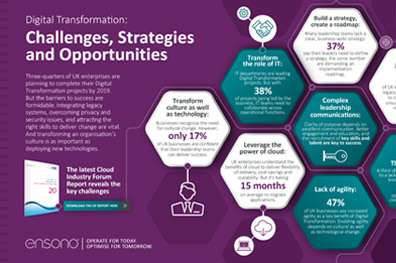Organisations have been on a steady march towards the Cloud for some time now, with a recent Cloud Industry Forum survey showing nearly 90% of organisations having adopted multiple Cloud based services. Interestingly, 72% of organisations have sought to move to Cloud in search of cost savings and 36% are using the approach to replace legacy systems. Only 29% cite enabling innovation and 27% business agility as their primary objective in making the change.
Thus it would seem that we are applying some very traditional IT values to the business case for becoming more Cloud centric. The same survey shows only 44% have a tangible digital transformation strategy. Whilst a further 32% believe their organisations recognise the need for digital transformation, it is clear that over half of those surveyed are not yet in transformation mode. With the current pace of change and the constant entry into multiple markets of disruptor organisations, what must organisations do to avoid becoming irrelevant in their markets?
Culture matters in IT
The enduring problem with IT in many organisations is one of culture rather than an explicit issue with technology. IT has evolved as a highly risk-averse function and one that, despite the endless calls to the contrary, is still often regarded as a cost centre. This would explain the high percentage of organisations seeking cost savings from the Cloud and the disappointingly low percentage of those seeking innovation and business agility. Sadly, many of those with cost savings as their primary objective will often fail to attain their goal as Cloud services, when measured with all the associated financial elements, are rarely significantly cheaper than more traditional systems over time.
The cultural issue shows again when examining the responses with 47% of the respondents citing legacy applications as a barrier to digital transformation. This is suggestive that legacy is not being embraced as part of the transformation journey but is rather a separate element that must somehow be overcome before the journey can begin. However, this is taking a very narrow view of digital transformation.
Legacy will carry on
Is this narrow view one that emanates from within IT, or is it a perception that the business has developed over time? Does the business see the new digital world as one that is only viable with new and shiny technology, or is it that IT is struggling conceptually to deliver legacy computing in a fresh and modern way? Generally the business simply assumes that the legacy will continue to deliver as reliably as it ever has, whilst innovative new approaches are added, but IT often struggles to deliver on this concept.
The existence of both legacy and transformational solutions have given rise to the concept of Bi-Modal, or two speed IT, where legacy is relegated to a secondary role of ‘just running’ and the creative effort is focused on the transformational aspects. In many organisations, the split is more pronounced, with legacy being left under the aegis of IT and transformation being devolved into other functions such as Marketing or even newly created digital departments. This approach has the effect of isolating legacy technology and often creates multiple and frequently disparate strategies
Isolating the heritage of an organisation in this way is to fundamentally miss the point of transformation. Legacy should not be seen as slowing or blocking transformation but rather as the enabler. Many of the techniques in use in, for example DevOps, are inherited from legacy environments such as mainframes. With many organisations citing skill shortages as slowing their ability to transform, looking within to the existing legacy environments and the staff who have developed and maintain these can yield surprisingly effective results. Transformation is not the sole domain of post-millennials: the experience, knowledge and efficiency of legacy operations can be very effectively re-directed, if strong cultural change is affected. Transformation is not an add-on to an organisation. To be effective, transformation must take the existing value of an organisation, build upon this, and apply innovation as an additional layer.
Conclusion
If we take this approach, we should see a change in the profile of Cloud adoption such that innovation and business agility become the primary drivers and legacy becomes a valuable foundation component rather than a blocker.













